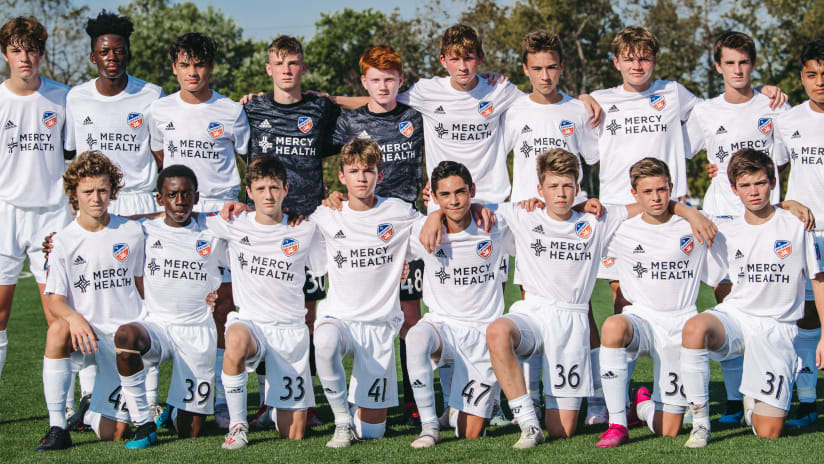NOTE: Every day this week, FC Cincinnati will take a deeper look at various academy programs across MLS that stand out for either their success in developing players for the first team – and international transfers – or for their methodology in training and/or integration into the first team. Last week, we started with an overview. The first four teams featured were Sporting Kansas City, the Philadelphia Union, Real Salt Lake and FC Dallas.
“I was just in Germany and they say it takes 10 years and a lot of bravery to change a philosophy. Hopefully, I just got Larry a 10-year contract.”
- Philadelphia Union Academy Director Tommy Wilson
This past week, I explored some of the best academy models in MLS. At this point, the achievements of those four clubs are still merely ambitions for the FC Cincinnati Academy, which formally launched on Aug. 1.
FC Dallas, who lead MLS with 26 Homegrown Players signings, have produced more HGs than weeks the FCC Academy has existed (21).
But the time that passes between now and the moment Cincinnati signs its first Homegrown Player doesn’t matter – yet. What matters is FCC have a structure in place to – eventually – create a wave of Cincinnati-area natives representing the Orange and Blue.
What the Academy has now
The FC Cincinnati Academy has eight full-time employees who help oversee two youth teams: the Under 15s and Under 17s. These teams launched in August, played their first competitive matches later that month and hosted their first home matches at the Mercy Health Training Center on Sept. 28.
Speaking of MHTC, the Academy has their own wing of the building that can be expanded when more teams are eventually added. The Academy is headquartered in state-of-the-art facilities.
When the facility opened last month, FCC majority owner Carl H. Lindner III said the building will house the next professional soccer players from the Queen City, while also serving as aspirational goal for local youth players to earn a place in the Academy.
MHTC is also where GM Gerard Nijkamp and Larry Sunderland, the club’s director of player development, are building an academy from scratch.
Both arrived in mid-2019 with the opportunity to start fresh and build something special.
For Sunderland, this isn’t his first build from scratch. He established the Chicago Fire Academy and helped the Portland Timbers rethink their development system. As for Nijkamp, he was PEC Zwolle’s academy director before eventually becoming the technical director. This past summer, one of his former academy players was sold to Liverpool, the current European champions.
That move shows demonstrates how Nijkamp’s commitment to youth teams can generate revenue for the club … in the form of multi-million dollar transfer fees.
For Sunderland, he’s also the U-16 U.S. Boys National Team coach and he arrived in Cincinnati with a great reputation among other academy directors across MLS.

“He’s a great guy with a lot of insight,” FCD Academy Director Chris Hayden said about Sunderland. “He’s been at two MLS clubs, which I think is really a great resource because he’s been in the trenches working with a set of circumstances and trying to better an environment. Then he went somewhere completely different and he worked through those circumstances, too.
“He’s not new to this,” Hayden added. “It’s really easy to take the good in the places he’s worked and implement those things. I think he’ll have a lot of background that a typical academy director wouldn’t.”
One of the first things Sunderland and his staff added was the Discovery Program, FCC’s pre-academy setup to identify local youth talent. This is a standard across MLS academies, but it’s arrival in Cincinnati means the current coaches are already scouting local talent and identifying players who could join the U-15 team in the near future.
What’s in the works for the Academy
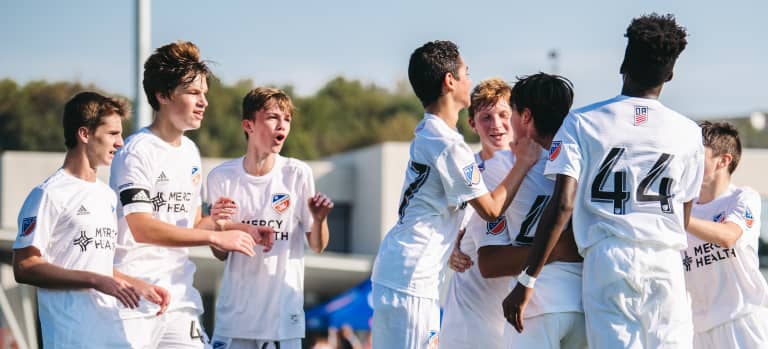
FC Cincinnati will eventually expand the pathway between the U-17 team – currently the oldest age group – and the first team.
Based on the current setup, it’s more likely for FCC to send academy graduates to college soccer programs instead of the MLS roster, but that’s because of the current age gap.
Expect that to shrink, though.
“A reserve team is needed for the future because if you have an academy and now it stops at 17 years old, maybe in the near future we will have an Under 19 (team), Nijkamp told supporters during FCC’s first-ever Town Hall event on Sept. 5. “For Under-17, Under-19 players, then you have to go directly into the first team, and that’s too big of a gap.”
While a U-19 team means more players would join the Academy, it would also allow the current players to have 2-4 years in the organization before turning 19 years old. That’s what other MLS teams have done – and have found success doing.
In theory, current and future youth players will be more likely to earn a professional contract the longer they played in the Cincinnati developmental setup because of the coaching, competition and culture.
Nijkamp also hopes that the development pathway will soon include some version of a reserve team.
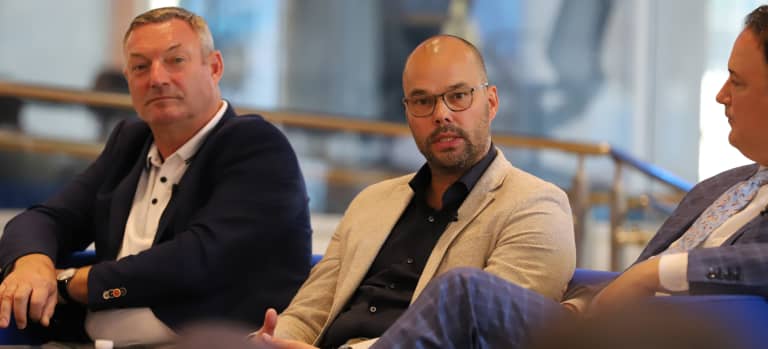
Since FC Cincinnati left the USL after the 2018 season, the club has fielded questions of whether or not it would create a USL team to act as a reserve side. There’s also a possibility to have an affiliate in the lower leagues.
When asked about this at the Town Hall, team president Jeff Berding said FCC have held discussions with clubs about formalizing an affiliate relationship with a USL Championship team, but that was “to be determined.”
Once Cincinnati can establish a second team, whether it’s in the USL Championship or League One (the third division), it’ll provide another platform for Academy talent to showcase their skills and allow Sunderland and Nijkamp more opportunities to further evaluate the players in the development sysyetm.
This is becoming the standard across MLS. Of the four teams I examined this week, three have a USL Championship team. Real Salt Lake’s second team, Real Monarchs, just won the USL Championship. FC Dallas’ team in USL League One, North Texas SC, were the top team during the regular season and swept opponents in the playoffs.
For any club with ambitions of signing Homegrown Players, this is a necessity across the world.
“As a coach, I have 25 players and three goalkeepers,” coach Ron Jans said in early September. “Every week, 15 players are not playing. Those who are on the bench a lot, to improve as a player, you have to play.
“So, when they can play in the reserve team it’s very good,” he added. “When you are from the academy and maybe 19 years old, (it’s a) step to the first team.”
Filling in the triangle
As Berding, Jans and Nijkamp spoke about the possibility of adding teams during the Town Hall, a PowerPoint presentation filled screens above their couch.
On the screen was a triangle, with a blue base, white middle and orange top.
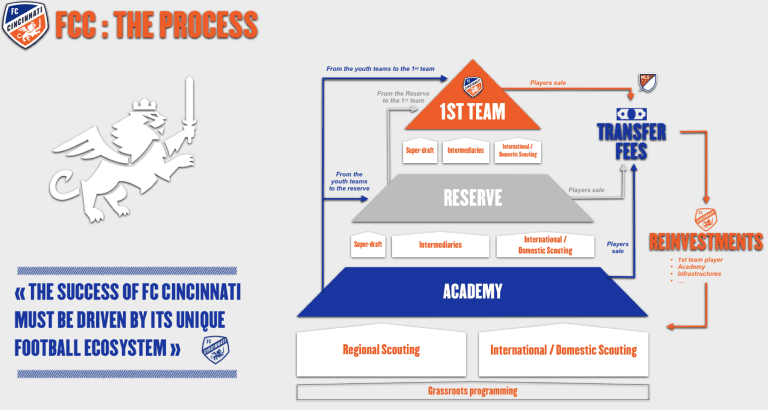
This is the formula of FC Cincinnati’s future.
Notice the size of the base – that’s the value the FC Cincinnati Academy will have on the club.
“There was a lot of preparation from scratch and a big challenge to get a professional, well-organized and good structured academy into place,” Nijkamp said of FCC’s academy prep work. “I think it’s a big need for every club because it’s not only to deliver and produce young talent to get into the first team, but also to give a face to the region.”
Moving forward, it’s critical that Jans and Nijkamp can add the top players from the FC Cincinnati Academy into the first team. It’s equally as important that Sunderland and his staff can supply good enough talent to fill the MLS roster.
Once both of these aspects become a cycle, then expect FCC to start signing one Homegrown Player after another.
Of course, during this process, this means more players are playing within the organization. If Nijkamp decides there’s an offer good enough, he can also sell a player to another club and use the money to either invest into the first team, the reserve team or to reinvest into the Academy.
What comes next
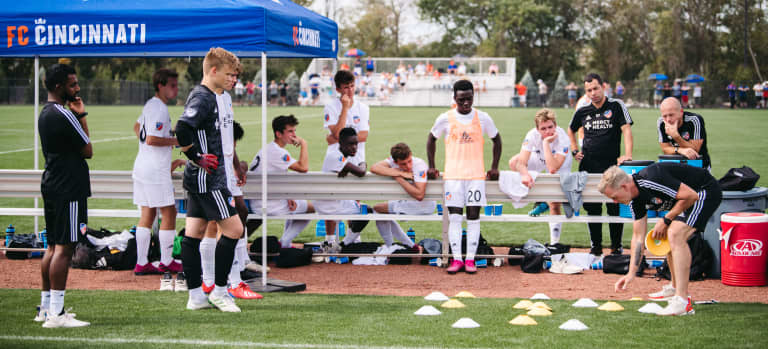
Sunderland’s first statement with the FC Cincinnati Academy sums up his beliefs:
“I believe that closing the gap between youth and professional development here in the U.S requires a dedicated focus,” he said in a press release. “It begins with our academy and ends with first-team opportunities for our players. What happens in between is the stuff that energizes me.”
Can Cincinnati close the gap from the Academy to first team with more teams to complete the pathway?
Is a long-term goal to have a residency program? If so, would it require host families like Sporting Kansas City or dorms like Real Salt Lake? Maybe FCC could even open their own school like RSL, but that’s not a primary concern for an Academy that’s not even a year old yet.
There will be a future when the FCC Academy could supply the majority of the first team roster. As this process continues, Orange and Blue supporters will literally see local players representing the club in the future West End Stadium.
And if star players leave, then that money will be reinvested for the next crop of talent bubbling below the surface.
This isn’t that far way.
Final thoughts
Last Sunday, Manchester United FC drew Everton, 1-1. The result was nothing to remember.
What’s spectacular, though, is the milestone that was reached that night at Old Trafford.
The match was the 4,000th-consecutive game that United included at least one academy product in either their starting XI or matchday squad. That feat, doesn’t look to end any time soon, dates back to Oct. 30, 1937.
“They can only impress when you give them a chance,” coach Ole Gunnar Solskjaer said.
FC Cincinnati and clubs around the world aspire to achieve a mark like that.
FCC ownership shares that value of playing youth players now. But can the Academy players produce the players to made it happen soon? The answer isn’t yes, but rather when.
The beauty of starting an academy from scratch is you plan your own path.
What’s the path Nijkamp and Sunderland lead the FC Cincinnati Academy toward?

